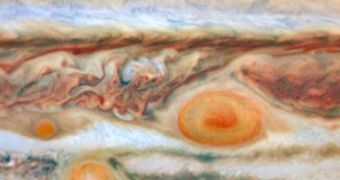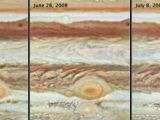Images provided by NASA's Hubble Space Telescope reveal that the collision between Jupiter's Great Red Spot and the Third Red Spot has all but destroyed the latter. All that was left behind was only a deformed and pale structure that is likely to be sucked completely into the giant anticyclone that has been raging through the atmosphere of the planet for more than three centuries. The pictures have been captured with the Wide Field and Planetary Camera 2, created by the Jet Propulsion Laboratory in Pasadena.
The sequence of three images (see lower picture) has been taken throughout the past three months, the latest of which on July 9, and shows how the Red Spot and the Third Red Spot move towards the position of the Great Red Spot. The Red Spot appeared in the early days of 2006, after suddenly turning from the color white to red, followed by the Third Red Spot on May 9, 2008. Although the smallest of the three storms appears to have been torn apart by the giant anticyclone, the middle member of the 'family' escaped mostly unharmed from yet another encounter with its larger companion.
Ever since it appeared, it was clear that the third spot wasn't going to last for a long time in the planet's atmosphere, since it was located at about the same latitude as the Great Red Spot. The deformed shape sitting to the right side of largest known storm in the solar system has been identified as the remnant of the baby spot, and will probably disappear altogether into the powerful winds of the Great Red Spot. Astronomers now believe that this might be one way through which the giant anticyclone sustained itself for the last 150 years.
Each of the images provided by Hubble's Wide Field Planetary Camera covers about 58 degrees of latitude and 70 degrees longitude of the planet, and all were taken in natural-color.

 14 DAY TRIAL //
14 DAY TRIAL // 
